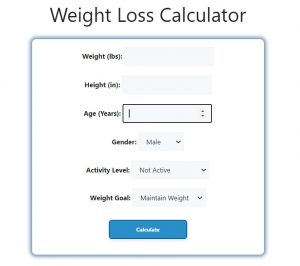About Weight Loss Calculator (Formula)
A Weight Loss Calculator is a valuable tool designed to help individuals monitor their caloric intake and maintain a healthy weight. Understanding how many calories you need to consume daily is crucial for achieving weight loss goals. By calculating your Basal Metabolic Rate (BMR) and adjusting for activity levels and desired weight loss, you can create a tailored plan that fits your lifestyle. This article will guide you through the formula, usage, and benefits of using a Weight Loss Calculator.
Formula
To calculate your daily caloric intake for weight loss, use the following formula:
Calories per day = BMR * A – WLC.
In this formula, BMR stands for Basal Metabolic Rate, A represents your activity level factor, and WLC denotes the desired weight loss calories.
How to Use
- Calculate Your BMR:
Determine your BMR using a standard calculation based on your age, gender, height, and weight. - Determine Your Activity Level:
Assess your daily activity level and assign a multiplier (A) based on your lifestyle:- Sedentary (little to no exercise): 1.2
- Lightly active (light exercise/sports 1-3 days a week): 1.375
- Moderately active (moderate exercise/sports 3-5 days a week): 1.55
- Very active (hard exercise/sports 6-7 days a week): 1.725
- Super active (very hard exercise/sports and a physical job): 1.9
- Set Your Weight Loss Goals:
Decide how much weight you want to lose and calculate the calories associated with that goal (WLC). - Insert Values into the Formula:
Input your BMR, activity level factor, and weight loss calories into the formula to find your daily caloric intake.
Example
Let’s consider an example for clarity:
- BMR: 1,600 calories (calculated based on personal factors)
- Activity Level: Moderately active (A = 1.55)
- Desired Weight Loss Calories (WLC): 500 calories
Using the formula:
Calories per day = 1,600 * 1.55 – 500
Calories per day = 2,480 – 500 = 1,980 calories
In this example, to achieve the desired weight loss, the individual should aim for a daily caloric intake of 1,980 calories.

FAQs
1. What is BMR?
Basal Metabolic Rate (BMR) is the number of calories your body needs at rest to maintain basic physiological functions.
2. Why is it important to calculate BMR?
Calculating your BMR helps you understand how many calories your body needs, which is essential for managing weight effectively.
3. What factors affect BMR?
BMR is influenced by age, gender, weight, height, and body composition.
4. How do I determine my activity level?
Your activity level can be assessed based on your daily routine and exercise habits, with specific multipliers assigned for different levels of activity.
5. What is the significance of the WLC?
The Weight Loss Calories (WLC) is the number of calories you plan to reduce from your daily intake to achieve your weight loss goal.
6. How often should I recalculate my BMR?
You should recalculate your BMR every few months or after significant weight changes to ensure accuracy in your weight loss plan.
7. Can I use the Weight Loss Calculator for muscle gain?
Yes, you can modify the formula to calculate the necessary caloric intake for muscle gain by adjusting the WLC to a positive value.
8. Is a daily caloric deficit safe?
A moderate daily caloric deficit is generally safe for most people, but it’s important to consult a healthcare provider before making significant changes.
9. How can I track my caloric intake?
You can track your caloric intake using apps, food diaries, or by reading nutrition labels.
10. What types of foods should I include in my diet?
Focus on whole foods, including fruits, vegetables, lean proteins, whole grains, and healthy fats, to meet your caloric needs while ensuring nutrition.
11. How long will it take to see results?
Weight loss results vary by individual but generally take several weeks to become noticeable with consistent effort.
12. Can stress affect my weight loss?
Yes, stress can influence eating habits and metabolism, potentially impacting weight loss efforts.
13. Should I exercise while trying to lose weight?
Incorporating regular exercise can enhance weight loss efforts and improve overall health.
14. What if I don’t lose weight despite following the calculator?
If weight loss stalls, consider reassessing your caloric intake, activity level, and dietary habits.
15. Are there any risks associated with rapid weight loss?
Yes, rapid weight loss can lead to muscle loss, nutritional deficiencies, and other health issues.
16. Can I lose weight without counting calories?
While counting calories is effective, you can also focus on portion control, healthy eating habits, and regular physical activity for weight loss.
17. What are some common mistakes people make with weight loss?
Common mistakes include underestimating portion sizes, neglecting exercise, and not tracking progress.
18. How can I stay motivated during my weight loss journey?
Setting realistic goals, tracking progress, and seeking support from friends or communities can help maintain motivation.
19. Is it okay to have cheat meals?
In moderation, cheat meals can be part of a healthy diet, but it’s essential to balance them with your overall caloric goals.
20. What should I do if I hit a weight loss plateau?
Reassess your caloric intake and activity levels, and consider changing your exercise routine or diet to break through the plateau.
Conclusion
The Weight Loss Calculator is an essential tool for anyone looking to manage their weight effectively. By calculating your caloric needs based on BMR, activity level, and desired weight loss, you can create a personalized plan that aligns with your goals. Remember, successful weight loss is not just about reducing calories but also maintaining a balanced diet and incorporating regular physical activity. With the right approach, you can achieve your weight loss objectives and lead a healthier lifestyle.